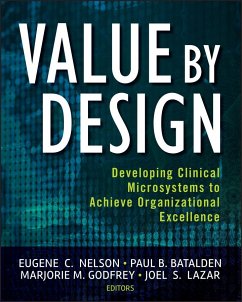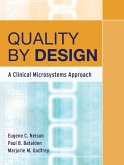Eugene C Nelson, Paul B Batalden, Marjorie M Godfrey, Joel S Lazar
Value by Design
Developing Clinical Microsystems to Achieve Organizational Excellence
Eugene C Nelson, Paul B Batalden, Marjorie M Godfrey, Joel S Lazar
Value by Design
Developing Clinical Microsystems to Achieve Organizational Excellence
- Broschiertes Buch
- Merkliste
- Auf die Merkliste
- Bewerten Bewerten
- Teilen
- Produkt teilen
- Produkterinnerung
- Produkterinnerung
VALUE BY DESIGN Value by Design is a practical guide for real-world improvement in clinical microsystems. Clinical microsystem theory, as implemented by the Institute for Healthcare Improvement and health care organizations nationally and internationally, is the foundation of high-performing front line health care teams who achieve exceptional quality and value. These editors combine theory and principles to create a strategic framework and field-tested tools to assess and improve systems of care. Their approach links patients, families, health care professionals and strategic organizational…mehr
Andere Kunden interessierten sich auch für
![Value-Based Health Care Value-Based Health Care]() Yosef D DlugaczValue-Based Health Care96,99 €
Yosef D DlugaczValue-Based Health Care96,99 €![Quality by Design Quality by Design]() Eugene C. NelsonQuality by Design107,99 €
Eugene C. NelsonQuality by Design107,99 €![Medical Device Design for Six SIGMA Medical Device Design for Six SIGMA]() Basem El-HaikMedical Device Design for Six SIGMA228,99 €
Basem El-HaikMedical Device Design for Six SIGMA228,99 €![Cost-Effectiveness Analysis in Health Cost-Effectiveness Analysis in Health]() Peter MuennigCost-Effectiveness Analysis in Health117,99 €
Peter MuennigCost-Effectiveness Analysis in Health117,99 €![Transforming Health Care Leadership Transforming Health Care Leadership]() Michael MaccobyTransforming Health Care Leadership64,99 €
Michael MaccobyTransforming Health Care Leadership64,99 €![Designing and Conducting Health Surveys Designing and Conducting Health Surveys]() Lu A. AdayDesigning and Conducting Health Surveys98,99 €
Lu A. AdayDesigning and Conducting Health Surveys98,99 €![Fundamentals of Health Care Financial Management Fundamentals of Health Care Financial Management]() Steven BergerFundamentals of Health Care Financial Management105,99 €
Steven BergerFundamentals of Health Care Financial Management105,99 €-
-
-
VALUE BY DESIGN Value by Design is a practical guide for real-world improvement in clinical microsystems. Clinical microsystem theory, as implemented by the Institute for Healthcare Improvement and health care organizations nationally and internationally, is the foundation of high-performing front line health care teams who achieve exceptional quality and value. These editors combine theory and principles to create a strategic framework and field-tested tools to assess and improve systems of care. Their approach links patients, families, health care professionals and strategic organizational goals at all levels of the organization: micro, meso and macrosystem levels to achieve the ultimate quality and value a health care system is capable of offering. Based on research and classes conducted at the Center for Health Care Improvement Leadership at The Dartmouth Institute for Health Policy and Clinical Practice, Value by Design: * Covers the foundations of quality, safety, cost improvement, assessment of system performance, and measurement of quality and value * Shows how to apply the proven clinical microsystems approach * Explains how to apply microsystem concepts and methods in a variety of care settings * Offers specific statistical tools for quality and process improvement, such as star diagrams and lean methods. In addition, the book includes a summary of take-home points and study questions for discussion in small groups as well as illustrative examples of completed working assignments.
Hinweis: Dieser Artikel kann nur an eine deutsche Lieferadresse ausgeliefert werden.
Hinweis: Dieser Artikel kann nur an eine deutsche Lieferadresse ausgeliefert werden.
Produktdetails
- Produktdetails
- Verlag: John Wiley & Sons / Wiley
- Seitenzahl: 384
- Erscheinungstermin: 8. März 2011
- Englisch
- Abmessung: 255mm x 205mm x 22mm
- Gewicht: 915g
- ISBN-13: 9780470385340
- ISBN-10: 0470385340
- Artikelnr.: 32205100
- Herstellerkennzeichnung
- Libri GmbH
- Europaallee 1
- 36244 Bad Hersfeld
- gpsr@libri.de
- Verlag: John Wiley & Sons / Wiley
- Seitenzahl: 384
- Erscheinungstermin: 8. März 2011
- Englisch
- Abmessung: 255mm x 205mm x 22mm
- Gewicht: 915g
- ISBN-13: 9780470385340
- ISBN-10: 0470385340
- Artikelnr.: 32205100
- Herstellerkennzeichnung
- Libri GmbH
- Europaallee 1
- 36244 Bad Hersfeld
- gpsr@libri.de
The Editors Eugene C. Nelson, DSC, MPH, is director of Population Health and Measurement for the Dartmouth-Hitchcock Medical Center and professor of Community and Family Medicine at Dartmouth Medical School and the Dartmouth Institute for Health Policy and Clinical Practice. He is the recipient of the Joint Commission on Accreditation of Healthcare Organizations' Ernest A. Codman award for his work on outcomes measurement in health care. Paul B. Batalden, MD, is professor of Pediatrics and of Community and Family Medicine at Dartmouth Medical School. He is the associate director of the Dartmouth-Hitchcock Leadership Preventive Medicine Residency, and teaches at the Dartmouth Institute for Health Policy and Clinical Practice, the Institute for Healthcare Improvement and in the Jönköping Academy for the Improvement of Health and Welfare in Sweden. Marjorie M. Godfrey, MS, RN, is codirector of the Microsystem Academy, instructor for the Dartmouth Institute for Health Policy and Clinical Practice, Dartmouth Medical School, and a recognized national and international leader in health care improvement with interdisciplinary professionals. Joel S. Lazar, MD, MPH, is assistant professor of Community and Family Medicine at the Dartmouth Institute for Health Policy and Clinical Practice and section chief and medical director of Family Medicine at Dartmouth-Hitchcock Medical Center, where he also serves as director of quality improvement. Companion Web site: www.josseybass.com/go/nelson
Figures and Tables xi
Foreword Elliott S. Fisher xvii
Preface: Improvement at the Front Line of Care xxi
Acknowledgments xxix
The Editors xxxiii
The Contributors xxxv
1 Introducing Clinical Microsystems 1
Learning Objectives 1
Microsystems in Health Care 1
A Broader View of Systems and Microsystems 6
Research on Microsystems in Health Care 11
Three Conceptual Imperatives in the Work of Value Improvement 20
Conclusion 24
Summary 25
Key Terms 25
Review Questions 26
Discussion Questions 26
References 26
Chapter One Action Guide 29
Introduction to the 5PS 29
The Clinical Microsystem Process and Structure of the 5Ps Model 29
External Mapping Tool 35
Microsystem Assessment Tool (MAT) 40
2 Partnering with Patients to Design and Improve Care 47
Learning Objectives 47
The Aim of Health Care and the Need to Partner with Patients 48
Conceptual Frameworks for Partnering with Patients 51
Tactics for Partnering with Patients 61
Patients as Informants and Advisors 65
Conclusion 67
Summary 67
Key Terms 67
Review Questions 68
Discussion Questions 68
References 68
Chapter Two Action Guide 71
Gaining Customer Knowledge 71
Institute for Patient and Family-Centered Care Matrix 82
Value Stream Mapping 83
Definitions of Selected Value Stream Mapping Terms 84
3 Improving Safety and Anticipating Hazards in Clinical Microsystems 87
Learning Objectives 87
Case Study of Organizational Factors to Promote a Culture of Safety 88
Discussion 92
Definitions 93
Identification of Medical Errors and Adverse Events 94
Frequency of Adverse Events and Medical Errors 95
Conclusion 107
Summary 107
Key Terms 108
Review Questions 108
Discussion Questions 109
References 109
Chapter Three Action Guide 113
5S Method 113
Checklists 116
Failure Mode and Effects Analysis 118
Rehearsals or Simulations 120
Designing Patient Safety into the Microsystem 122
The Link Between Safety, the Microsystem, and Mindfulness 123
Conclusion 129
References 130
4 Using Measurement to Improve Health Care Value 131
Learning Objectives 131
Measuring What Matters at All Levels of the System 132
Tips and Principles to Foster a Rich Information Environment 138
Designing Information Flow to Support High-Value Care 140
Conclusion 150
Summary 151
Key Terms 152
Review Questions 152
Discussion Questions 152
References 153
Chapter Four Action Guide 155
Patient Value Compass 155
Balanced Scorecard 156
Measure What Matters Worksheet 157
Examples of Data Walls 159
References 160
5 Starting the Patient's Care in Clinical Microsystems 161
Learning Objectives 161
The Entry Functions of Clinical Microsystems 162
Conclusion 182
Summary 183
Key Terms 183
Review Questions 183
Discussion Questions 184
References 184
Chapter Five Action Guide 187
Process Mapping with Flowcharts 187
Access Measures and Tools 190
CARE Vital Signs 192
Reference 195
6 Designing Preventive Care to Improve Health 197
Learning Objectives 197
The Work of Preventive Health Care 198
An Action-Based Taxonomy of Preventive Health Services 202
Conclusion 213
Summary 213
Key Terms 213
Review Questions 214
Discussion Questions 214
References 214
Chapter Six Action Guide 217
Radiology Microsystem Preventive Activity of Mammography and VAP Bundles in
Critical Care 217
7 Planning for Responsive and Reliable Acute Care 221
Learning Objectives 221
Anticipating the Needs of Acutely Ill Patients 222
Defining Acute Care Needs of Patients and Families 222
An Overview of Design Requirements for Acute Care 225
Advanced Access and Effective Care Transitions 233
Conclusion 235
Summary 236
Key Terms 236
Review Questions 236
Discussion Questions 237
References 237
Chapter Seven Action Guide 239
Microsystem Transitions and Handoffs 240
8 Engaging Complexity in Chronic Illness Care 241
Learning Objectives 241
An Invitation to Complexity 242
The Experience of Chronic Illness 244
The Burden of Chronic Illness 245
The Goals of Chronic Illness Care 248
Clinical Complexity in Chronic Illness Care 250
Designing for Complexity Through Alignment of Problems and Practice
Solutions 252
The Nature of Complex Adaptive Systems 254
The Chronic Care Model 255
Care Coordinaton and Transitions 260
Patient Self-Management 262
Conclusion 265
Summary 266
Key Terms 266
Review Questions 267
Discussion Questions 267
References 267
Chapter Eight Action Guide 271
STAR Generative Relationships 271
Reference 273
9 Supporting Patients and Families Through Palliative Care 277
Learning Objectives 277
The Need for Palliative Care in Modern America 278
End-of-Life Experience Yesterday and Today 279
Principles of Palliative Care 281
Reducing Variation in End-of-Life Care 283
Core Processes in Palliative Care 285
Care Coordination Near the End of Life 287
Formal Palliative Care and Hospice Programs 289
Planning for Both Life and Death with Advance Directives 291
Conclusion 293
Summary 295
Key Terms 295
Review Questions 295
Discussion Questions 296
References 296
Chapter Nine Action Guide 297
Mental Models 297
Using the Ladder of Inference to Explore Mental Models 297
Reference 301
10 Designing Health Systems to Improve Value 303
Learning Objectives 303
From Parts to Whole 304
New Vision of Integrated Systems to Produce High Value 305
The Execution Triangle 313
Leading Change at All Levels 315
Changing Local Culture 318
The Path Forward for Making High-Value Health Systems 323
Summary 326
Key Terms 326
Review Questions 326
Discussion Questions 327
References 327
Chapter Ten Action Guide 331
Micro-, Meso-, and Macrosystem Matrix 331
Index 335
Foreword Elliott S. Fisher xvii
Preface: Improvement at the Front Line of Care xxi
Acknowledgments xxix
The Editors xxxiii
The Contributors xxxv
1 Introducing Clinical Microsystems 1
Learning Objectives 1
Microsystems in Health Care 1
A Broader View of Systems and Microsystems 6
Research on Microsystems in Health Care 11
Three Conceptual Imperatives in the Work of Value Improvement 20
Conclusion 24
Summary 25
Key Terms 25
Review Questions 26
Discussion Questions 26
References 26
Chapter One Action Guide 29
Introduction to the 5PS 29
The Clinical Microsystem Process and Structure of the 5Ps Model 29
External Mapping Tool 35
Microsystem Assessment Tool (MAT) 40
2 Partnering with Patients to Design and Improve Care 47
Learning Objectives 47
The Aim of Health Care and the Need to Partner with Patients 48
Conceptual Frameworks for Partnering with Patients 51
Tactics for Partnering with Patients 61
Patients as Informants and Advisors 65
Conclusion 67
Summary 67
Key Terms 67
Review Questions 68
Discussion Questions 68
References 68
Chapter Two Action Guide 71
Gaining Customer Knowledge 71
Institute for Patient and Family-Centered Care Matrix 82
Value Stream Mapping 83
Definitions of Selected Value Stream Mapping Terms 84
3 Improving Safety and Anticipating Hazards in Clinical Microsystems 87
Learning Objectives 87
Case Study of Organizational Factors to Promote a Culture of Safety 88
Discussion 92
Definitions 93
Identification of Medical Errors and Adverse Events 94
Frequency of Adverse Events and Medical Errors 95
Conclusion 107
Summary 107
Key Terms 108
Review Questions 108
Discussion Questions 109
References 109
Chapter Three Action Guide 113
5S Method 113
Checklists 116
Failure Mode and Effects Analysis 118
Rehearsals or Simulations 120
Designing Patient Safety into the Microsystem 122
The Link Between Safety, the Microsystem, and Mindfulness 123
Conclusion 129
References 130
4 Using Measurement to Improve Health Care Value 131
Learning Objectives 131
Measuring What Matters at All Levels of the System 132
Tips and Principles to Foster a Rich Information Environment 138
Designing Information Flow to Support High-Value Care 140
Conclusion 150
Summary 151
Key Terms 152
Review Questions 152
Discussion Questions 152
References 153
Chapter Four Action Guide 155
Patient Value Compass 155
Balanced Scorecard 156
Measure What Matters Worksheet 157
Examples of Data Walls 159
References 160
5 Starting the Patient's Care in Clinical Microsystems 161
Learning Objectives 161
The Entry Functions of Clinical Microsystems 162
Conclusion 182
Summary 183
Key Terms 183
Review Questions 183
Discussion Questions 184
References 184
Chapter Five Action Guide 187
Process Mapping with Flowcharts 187
Access Measures and Tools 190
CARE Vital Signs 192
Reference 195
6 Designing Preventive Care to Improve Health 197
Learning Objectives 197
The Work of Preventive Health Care 198
An Action-Based Taxonomy of Preventive Health Services 202
Conclusion 213
Summary 213
Key Terms 213
Review Questions 214
Discussion Questions 214
References 214
Chapter Six Action Guide 217
Radiology Microsystem Preventive Activity of Mammography and VAP Bundles in
Critical Care 217
7 Planning for Responsive and Reliable Acute Care 221
Learning Objectives 221
Anticipating the Needs of Acutely Ill Patients 222
Defining Acute Care Needs of Patients and Families 222
An Overview of Design Requirements for Acute Care 225
Advanced Access and Effective Care Transitions 233
Conclusion 235
Summary 236
Key Terms 236
Review Questions 236
Discussion Questions 237
References 237
Chapter Seven Action Guide 239
Microsystem Transitions and Handoffs 240
8 Engaging Complexity in Chronic Illness Care 241
Learning Objectives 241
An Invitation to Complexity 242
The Experience of Chronic Illness 244
The Burden of Chronic Illness 245
The Goals of Chronic Illness Care 248
Clinical Complexity in Chronic Illness Care 250
Designing for Complexity Through Alignment of Problems and Practice
Solutions 252
The Nature of Complex Adaptive Systems 254
The Chronic Care Model 255
Care Coordinaton and Transitions 260
Patient Self-Management 262
Conclusion 265
Summary 266
Key Terms 266
Review Questions 267
Discussion Questions 267
References 267
Chapter Eight Action Guide 271
STAR Generative Relationships 271
Reference 273
9 Supporting Patients and Families Through Palliative Care 277
Learning Objectives 277
The Need for Palliative Care in Modern America 278
End-of-Life Experience Yesterday and Today 279
Principles of Palliative Care 281
Reducing Variation in End-of-Life Care 283
Core Processes in Palliative Care 285
Care Coordination Near the End of Life 287
Formal Palliative Care and Hospice Programs 289
Planning for Both Life and Death with Advance Directives 291
Conclusion 293
Summary 295
Key Terms 295
Review Questions 295
Discussion Questions 296
References 296
Chapter Nine Action Guide 297
Mental Models 297
Using the Ladder of Inference to Explore Mental Models 297
Reference 301
10 Designing Health Systems to Improve Value 303
Learning Objectives 303
From Parts to Whole 304
New Vision of Integrated Systems to Produce High Value 305
The Execution Triangle 313
Leading Change at All Levels 315
Changing Local Culture 318
The Path Forward for Making High-Value Health Systems 323
Summary 326
Key Terms 326
Review Questions 326
Discussion Questions 327
References 327
Chapter Ten Action Guide 331
Micro-, Meso-, and Macrosystem Matrix 331
Index 335
Figures and Tables xi
Foreword Elliott S. Fisher xvii
Preface: Improvement at the Front Line of Care xxi
Acknowledgments xxix
The Editors xxxiii
The Contributors xxxv
1 Introducing Clinical Microsystems 1
Learning Objectives 1
Microsystems in Health Care 1
A Broader View of Systems and Microsystems 6
Research on Microsystems in Health Care 11
Three Conceptual Imperatives in the Work of Value Improvement 20
Conclusion 24
Summary 25
Key Terms 25
Review Questions 26
Discussion Questions 26
References 26
Chapter One Action Guide 29
Introduction to the 5PS 29
The Clinical Microsystem Process and Structure of the 5Ps Model 29
External Mapping Tool 35
Microsystem Assessment Tool (MAT) 40
2 Partnering with Patients to Design and Improve Care 47
Learning Objectives 47
The Aim of Health Care and the Need to Partner with Patients 48
Conceptual Frameworks for Partnering with Patients 51
Tactics for Partnering with Patients 61
Patients as Informants and Advisors 65
Conclusion 67
Summary 67
Key Terms 67
Review Questions 68
Discussion Questions 68
References 68
Chapter Two Action Guide 71
Gaining Customer Knowledge 71
Institute for Patient and Family-Centered Care Matrix 82
Value Stream Mapping 83
Definitions of Selected Value Stream Mapping Terms 84
3 Improving Safety and Anticipating Hazards in Clinical Microsystems 87
Learning Objectives 87
Case Study of Organizational Factors to Promote a Culture of Safety 88
Discussion 92
Definitions 93
Identification of Medical Errors and Adverse Events 94
Frequency of Adverse Events and Medical Errors 95
Conclusion 107
Summary 107
Key Terms 108
Review Questions 108
Discussion Questions 109
References 109
Chapter Three Action Guide 113
5S Method 113
Checklists 116
Failure Mode and Effects Analysis 118
Rehearsals or Simulations 120
Designing Patient Safety into the Microsystem 122
The Link Between Safety, the Microsystem, and Mindfulness 123
Conclusion 129
References 130
4 Using Measurement to Improve Health Care Value 131
Learning Objectives 131
Measuring What Matters at All Levels of the System 132
Tips and Principles to Foster a Rich Information Environment 138
Designing Information Flow to Support High-Value Care 140
Conclusion 150
Summary 151
Key Terms 152
Review Questions 152
Discussion Questions 152
References 153
Chapter Four Action Guide 155
Patient Value Compass 155
Balanced Scorecard 156
Measure What Matters Worksheet 157
Examples of Data Walls 159
References 160
5 Starting the Patient's Care in Clinical Microsystems 161
Learning Objectives 161
The Entry Functions of Clinical Microsystems 162
Conclusion 182
Summary 183
Key Terms 183
Review Questions 183
Discussion Questions 184
References 184
Chapter Five Action Guide 187
Process Mapping with Flowcharts 187
Access Measures and Tools 190
CARE Vital Signs 192
Reference 195
6 Designing Preventive Care to Improve Health 197
Learning Objectives 197
The Work of Preventive Health Care 198
An Action-Based Taxonomy of Preventive Health Services 202
Conclusion 213
Summary 213
Key Terms 213
Review Questions 214
Discussion Questions 214
References 214
Chapter Six Action Guide 217
Radiology Microsystem Preventive Activity of Mammography and VAP Bundles in
Critical Care 217
7 Planning for Responsive and Reliable Acute Care 221
Learning Objectives 221
Anticipating the Needs of Acutely Ill Patients 222
Defining Acute Care Needs of Patients and Families 222
An Overview of Design Requirements for Acute Care 225
Advanced Access and Effective Care Transitions 233
Conclusion 235
Summary 236
Key Terms 236
Review Questions 236
Discussion Questions 237
References 237
Chapter Seven Action Guide 239
Microsystem Transitions and Handoffs 240
8 Engaging Complexity in Chronic Illness Care 241
Learning Objectives 241
An Invitation to Complexity 242
The Experience of Chronic Illness 244
The Burden of Chronic Illness 245
The Goals of Chronic Illness Care 248
Clinical Complexity in Chronic Illness Care 250
Designing for Complexity Through Alignment of Problems and Practice
Solutions 252
The Nature of Complex Adaptive Systems 254
The Chronic Care Model 255
Care Coordinaton and Transitions 260
Patient Self-Management 262
Conclusion 265
Summary 266
Key Terms 266
Review Questions 267
Discussion Questions 267
References 267
Chapter Eight Action Guide 271
STAR Generative Relationships 271
Reference 273
9 Supporting Patients and Families Through Palliative Care 277
Learning Objectives 277
The Need for Palliative Care in Modern America 278
End-of-Life Experience Yesterday and Today 279
Principles of Palliative Care 281
Reducing Variation in End-of-Life Care 283
Core Processes in Palliative Care 285
Care Coordination Near the End of Life 287
Formal Palliative Care and Hospice Programs 289
Planning for Both Life and Death with Advance Directives 291
Conclusion 293
Summary 295
Key Terms 295
Review Questions 295
Discussion Questions 296
References 296
Chapter Nine Action Guide 297
Mental Models 297
Using the Ladder of Inference to Explore Mental Models 297
Reference 301
10 Designing Health Systems to Improve Value 303
Learning Objectives 303
From Parts to Whole 304
New Vision of Integrated Systems to Produce High Value 305
The Execution Triangle 313
Leading Change at All Levels 315
Changing Local Culture 318
The Path Forward for Making High-Value Health Systems 323
Summary 326
Key Terms 326
Review Questions 326
Discussion Questions 327
References 327
Chapter Ten Action Guide 331
Micro-, Meso-, and Macrosystem Matrix 331
Index 335
Foreword Elliott S. Fisher xvii
Preface: Improvement at the Front Line of Care xxi
Acknowledgments xxix
The Editors xxxiii
The Contributors xxxv
1 Introducing Clinical Microsystems 1
Learning Objectives 1
Microsystems in Health Care 1
A Broader View of Systems and Microsystems 6
Research on Microsystems in Health Care 11
Three Conceptual Imperatives in the Work of Value Improvement 20
Conclusion 24
Summary 25
Key Terms 25
Review Questions 26
Discussion Questions 26
References 26
Chapter One Action Guide 29
Introduction to the 5PS 29
The Clinical Microsystem Process and Structure of the 5Ps Model 29
External Mapping Tool 35
Microsystem Assessment Tool (MAT) 40
2 Partnering with Patients to Design and Improve Care 47
Learning Objectives 47
The Aim of Health Care and the Need to Partner with Patients 48
Conceptual Frameworks for Partnering with Patients 51
Tactics for Partnering with Patients 61
Patients as Informants and Advisors 65
Conclusion 67
Summary 67
Key Terms 67
Review Questions 68
Discussion Questions 68
References 68
Chapter Two Action Guide 71
Gaining Customer Knowledge 71
Institute for Patient and Family-Centered Care Matrix 82
Value Stream Mapping 83
Definitions of Selected Value Stream Mapping Terms 84
3 Improving Safety and Anticipating Hazards in Clinical Microsystems 87
Learning Objectives 87
Case Study of Organizational Factors to Promote a Culture of Safety 88
Discussion 92
Definitions 93
Identification of Medical Errors and Adverse Events 94
Frequency of Adverse Events and Medical Errors 95
Conclusion 107
Summary 107
Key Terms 108
Review Questions 108
Discussion Questions 109
References 109
Chapter Three Action Guide 113
5S Method 113
Checklists 116
Failure Mode and Effects Analysis 118
Rehearsals or Simulations 120
Designing Patient Safety into the Microsystem 122
The Link Between Safety, the Microsystem, and Mindfulness 123
Conclusion 129
References 130
4 Using Measurement to Improve Health Care Value 131
Learning Objectives 131
Measuring What Matters at All Levels of the System 132
Tips and Principles to Foster a Rich Information Environment 138
Designing Information Flow to Support High-Value Care 140
Conclusion 150
Summary 151
Key Terms 152
Review Questions 152
Discussion Questions 152
References 153
Chapter Four Action Guide 155
Patient Value Compass 155
Balanced Scorecard 156
Measure What Matters Worksheet 157
Examples of Data Walls 159
References 160
5 Starting the Patient's Care in Clinical Microsystems 161
Learning Objectives 161
The Entry Functions of Clinical Microsystems 162
Conclusion 182
Summary 183
Key Terms 183
Review Questions 183
Discussion Questions 184
References 184
Chapter Five Action Guide 187
Process Mapping with Flowcharts 187
Access Measures and Tools 190
CARE Vital Signs 192
Reference 195
6 Designing Preventive Care to Improve Health 197
Learning Objectives 197
The Work of Preventive Health Care 198
An Action-Based Taxonomy of Preventive Health Services 202
Conclusion 213
Summary 213
Key Terms 213
Review Questions 214
Discussion Questions 214
References 214
Chapter Six Action Guide 217
Radiology Microsystem Preventive Activity of Mammography and VAP Bundles in
Critical Care 217
7 Planning for Responsive and Reliable Acute Care 221
Learning Objectives 221
Anticipating the Needs of Acutely Ill Patients 222
Defining Acute Care Needs of Patients and Families 222
An Overview of Design Requirements for Acute Care 225
Advanced Access and Effective Care Transitions 233
Conclusion 235
Summary 236
Key Terms 236
Review Questions 236
Discussion Questions 237
References 237
Chapter Seven Action Guide 239
Microsystem Transitions and Handoffs 240
8 Engaging Complexity in Chronic Illness Care 241
Learning Objectives 241
An Invitation to Complexity 242
The Experience of Chronic Illness 244
The Burden of Chronic Illness 245
The Goals of Chronic Illness Care 248
Clinical Complexity in Chronic Illness Care 250
Designing for Complexity Through Alignment of Problems and Practice
Solutions 252
The Nature of Complex Adaptive Systems 254
The Chronic Care Model 255
Care Coordinaton and Transitions 260
Patient Self-Management 262
Conclusion 265
Summary 266
Key Terms 266
Review Questions 267
Discussion Questions 267
References 267
Chapter Eight Action Guide 271
STAR Generative Relationships 271
Reference 273
9 Supporting Patients and Families Through Palliative Care 277
Learning Objectives 277
The Need for Palliative Care in Modern America 278
End-of-Life Experience Yesterday and Today 279
Principles of Palliative Care 281
Reducing Variation in End-of-Life Care 283
Core Processes in Palliative Care 285
Care Coordination Near the End of Life 287
Formal Palliative Care and Hospice Programs 289
Planning for Both Life and Death with Advance Directives 291
Conclusion 293
Summary 295
Key Terms 295
Review Questions 295
Discussion Questions 296
References 296
Chapter Nine Action Guide 297
Mental Models 297
Using the Ladder of Inference to Explore Mental Models 297
Reference 301
10 Designing Health Systems to Improve Value 303
Learning Objectives 303
From Parts to Whole 304
New Vision of Integrated Systems to Produce High Value 305
The Execution Triangle 313
Leading Change at All Levels 315
Changing Local Culture 318
The Path Forward for Making High-Value Health Systems 323
Summary 326
Key Terms 326
Review Questions 326
Discussion Questions 327
References 327
Chapter Ten Action Guide 331
Micro-, Meso-, and Macrosystem Matrix 331
Index 335








